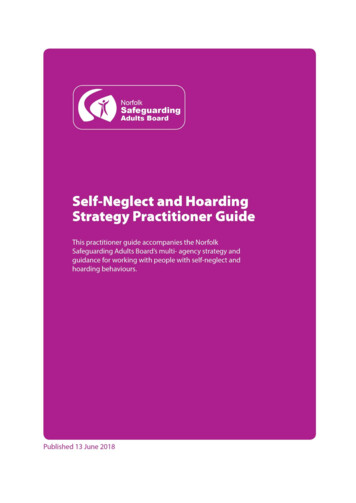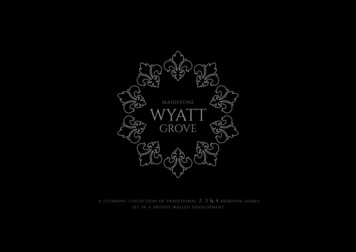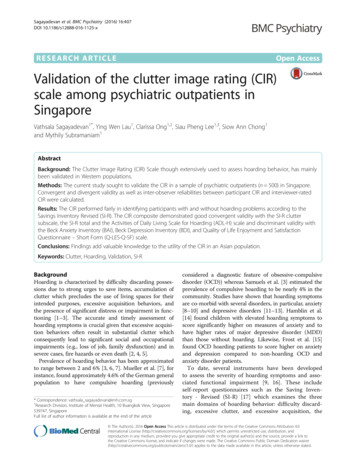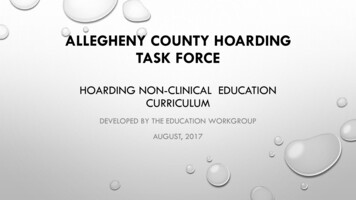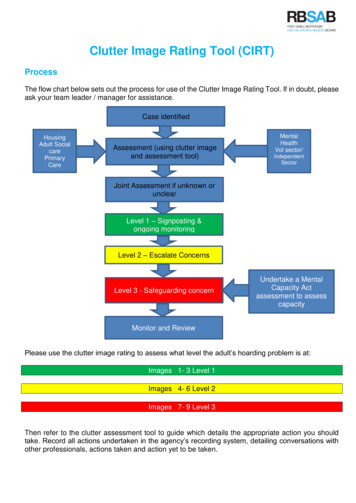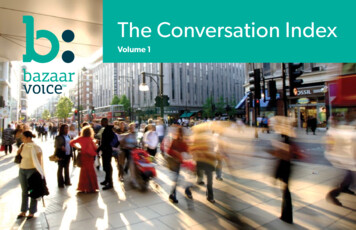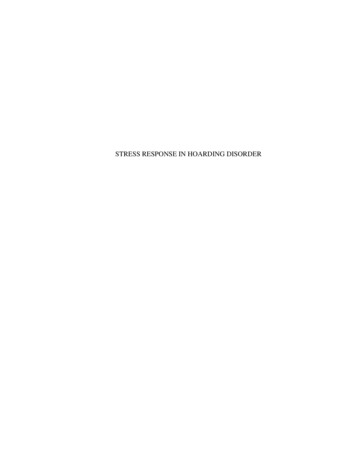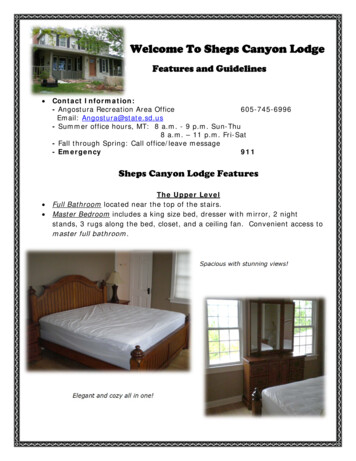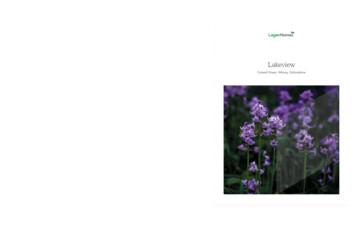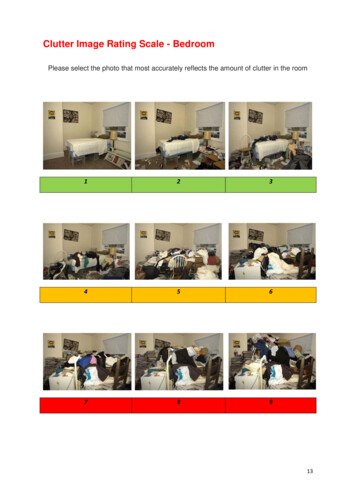
Transcription
Clutter Image Rating Scale - BedroomPlease select the photo that most accurately reflects the amount of clutter in the room12345678913
Clutter Image Rating Scale - LoungePlease select the photo that most accurately reflects the amount of clutter in the room12345678914
Clutter Image Rating Scale – KitchenPlease select the photo that most accurately reflects the amount of clutter in the room12345678915
16. Assessment Tool Guidelines1. Propertystructure,services &garden area 2. HouseholdFunctions3. Health andSafety 4. Safeguard ofChildren &Family members5. Animals andPests6. PersonalProtectiveEquipment(PPE)Assess the access to all entrances and exits for the property. (Noteimpact on any communal entrances & exits). Include access to roofspace.Does the property have a smoke alarm?Visual Assessment (non-professional) of the condition of the services(NPVAS) within the property e.g. plumbing, electrics, gas, air conditioning,heating, this will help inform your next course of action.Are the services connected?Assess the garden. size, access and condition.Assess the current functionality of the rooms and the safety for theirproposed use. E.g. can the kitchen be safely used for cooking or does thelevel of clutter within the room prevent it.Select the appropriate rating on the clutter scale.Please estimate the % of floor space covered by clutterPlease estimate the height of the clutter in each roomAssess the level of sanitation in the property.Are the floors clean?Are the work surfaces clean?Are you aware of any odours in the property?Is there rotting food?Does the resident use candles?Did you witness a higher than expected number of flies?Are household members struggling with personal care?Is there random or chaotic writing on the walls on the property?Are there unreasonable amounts of medication collected? Prescribed orover the counter?Is the resident aware of any fire risk associated to the clutter in theproperty? Do any rooms rate 7 or above on the clutter rating scale?Does the household contain young people or children? Are the any pets at the property?Are the pets well cared for; are you concerned about their health?Is there evidence of any infestation? E.g bed bugs, rats, mice, etc.Are animals being hoarded at the property?Are outside areas seen by the resident as a wildlife area?Does the resident leave food out in the garden to feed foxes etc.Following your assessment do you recommend the use of PersonalProtective Equipment (PPE) at future visits? Please detailFollowing your assessment do you recommend the resident is visited inpairs? Please detail 16
Level 1Clutter imagerating 1 - 31. Propertystructure,services &garden area 2. HouseholdFunctions Household environment is considered standard.No specialised assistance is needed. If the resident would like someassistance with general housework or feels they are decliningtowards a higher clutter scale, appropriate referrals can be madesubject to age and circumstances.All entrances and exits, stairways, roof space and windowsaccessible.Smoke alarms fitted and functional or referrals made to fire brigade tovisit and install.All services functional and maintained in good working order.Garden is accessible, tidy and maintainedNo excessive clutter, all rooms can be safely used for their intendedpurpose.All rooms are rated 0-3 on the Clutter Rating ScaleNo additional unused household appliances appear in unusuallocations around the propertyProperty is maintained within terms of any lease or tenancyagreements where appropriate.Property is not at risk of action by Environmental Health.3. Health andSafety Property is clean with no odours, (pet or other)No rotting foodNo concerning use of candlesNo concern over fliesResidents managing personal careNo writing on the wallsQuantities of medication are within appropriate limits, in date andstored appropriately.4.Safeguard ofChildren & Familymembers No Concerns for household members5. Animals andPests Any pets at the property are well cared forNo pests or infestations at the property6. PersonalProtectiveEquipment(PPE) No PPE requiredNo visit in pairs required.17
Level 1ActionsReferring Agency Discuss concerns with residentRaise a request to the Fire Brigade to provide fire safety adviceRefer for support assessment if appropriate.Refer to GP if appropriateEnvironmentalHealthSocial Landlords No Action Provide details on debt advice if appropriate to circumstancesRefer to GP if appropriateRefer for support assessment if appropriate.Provide details of support streams open to the resident via charitiesand self-help groups.Provide details on debt advice if appropriate to circumstancesEnsure residents are maintaining all tenancy conditionsPractitioners Complete Hoarding AssessmentMake appropriate referrals for supportRefer to social landlord if the client is their tenant or leaseholderEmergencyServices Ensure information is shared with statutory agencies & feedback isprovided to referring agency on completion of home visits.Animal Welfare No action unless advice requestedSafeguardingAdultsMASH No action unless other concerns of abuse are noted. No action unless other concerns of abuse are noted.18
Level 2Household environment requires professional assistance to resolve theclutter and the maintenance issues in the property.Clutter ImageRating 4 – 61. Propertystructure,services &garden area Only major exit is blockedOnly one of the services is not fully functionalConcern that services are not well maintainedSmoke alarms are not installed or not functioningGarden is not accessible due to clutter, or is not maintainedEvidence of indoor items stored outsideEvidence of light structural damage including dampInterior doors missing or blocked open2. HouseholdFunctions Clutter is causing congestion in the living spaces and isimpacting on the use of the rooms for their intended purpose.Clutter is causing congestion between the rooms and entrances.Room(s) score between 4-5 on the clutter scale.Inconsistent levels of housekeeping throughout the propertySome household appliances are not functioning properly andthere may be additional units in unusual places.Property is not maintained within terms of lease or tenancyagreement where applicable.Evidence of outdoor items being stored inside 3. Health andSafety Kitchen and bathroom are not kept cleanOffensive odour in the propertyResident is not maintaining safe cooking environmentSome concern with the quantity of medication, or its storage orexpiry dates.No rotting foodNo concerning use of candlesResident trying to manage personal care but strugglingNo writing on the walls4.Safeguard ofChildren & Familymembers 5. Animals andPests Pets at the property are not well cared forResident is not unable to control the animalsAnimal‟s living area is not maintained and smellsAnimals appear to be under nourished or over fedSound of mice heard at the property.Spider webs in houseLight insect infestation (bed bugs, lice, fleas, cockroaches, ants,etc)6. PersonalProtectiveEquipment(PPE) Latex Gloves, boots or needle stick safe shoes, face mask, handsanitizer, insect repellent.PPE required. Hoarding on clutter scale 4 -7 doesn‟t automatically constitute aSafeguarding Alert.Please note all additional concerns for householdersProperties with children or vulnerable residents with additionalsupport needs may trigger a Safeguarding Alert under a differentrisk.19
ActionsIn addition to actions listed below these cases need to be monitoredregularly in the future due toRISK OF ESCALATION or REOCURRENCELevel 2Referring Agency EnvironmentalHealth Refer to Environmental Health on 020 8545 3025 with details of client,landlord (if relevant) referrer‟s details and overview of problems At time of inspection, Environmental Health Officer decides onappropriate course of action Consider serving notices under Environmental Protection Act 1990,Prevention of Damage By Pests Act 1949 or Housing Act 2004Consider Works in Default if notices not complied by occupierSocial Landlord Visit resident to inspect the property & assess support needs Referral to Merton Generic Floating Support to assist in the restorationof services to the property where appropriate. Ensure residents are maintaining all tenancy conditions Enforce tenancy conditions relating to residents responsibilities Ensure information sharing with all agencies involved to ensure acollaborative approach and a sustainable resolution.Practitioners Refer to “Guidance for Hoarding Guidance Questions to Ask” Complete Practitioners Assessment ToolEnsure information sharing with all agencies involved to ensure acollaborative approach and a sustainable resolution. Refer to landlord if resident is a tenantRefer to Environmental Health is resident is a freeholderRaise an request to the Fire Brigade to provide fire prevention adviceProvide details of garden servicesRefer for support assessmentReferral to GPReferral to debt advice if appropriateRefer to Animal welfare if there are animals at the property.Ensure information sharing with all agencies involved to ensure acollaborative approach and a sustainable resolution. EmergencyServices Ensure information sharing with all agencies involved to ensure acollaborative approach and a sustainable resolution. Provide feedback to referring agency on completion of home visits.Animal Welfare Visit property to undertake a wellbeing check on animals at theproperty. Educate client regarding animal welfare if appropriate Provide advice / assistance with re-homing animalsSafeguardingAdults MASH No action unless other concerns of abuse are noted.If other concerns of abuse are of concern or have been reported,progression to safeguarding referral and investigation may benecessary.No action unless other concerns of abuse are noted20
Level 3Clutter imagerating7-91. Propertystructure,services& gardenarea2. HouseholdFunctionsHousehold environment will require intervention with a collaborative multi agencyapproach with the involvement from a wide range of professionals. This level ofhoarding constitutes a Safeguarding alert due to the significant risk to health of thehouseholders, surrounding properties and residents. Residents are often unaware of theimplication of their hoarding actions and oblivious to the risk it poses. Limited access to the property due to extreme clutterEvidence may be seen of extreme clutter seen at windowsEvidence may be seen of extreme clutter outside the propertyGarden not accessible and extensively overgrownServices not connected or not functioning properlySmoke alarms not fitted or not functioningProperty lacks ventilation due to clutterEvidence of structural damage or outstanding repairs including dampInterior doors missing or blocked openEvidence of indoor items stored outside Clutter is obstructing the living spaces and is preventing the use of the rooms fortheir intended purpose.Room(s) scores 7 - 9 on the clutter image scaleRooms not used for intended purposes or very limitedBeds inaccessible or unusable due to clutter or infestationEntrances, hallways and stairs blocked or difficult to passToilets, sinks not functioning or not in useResident at risk due to living environmentHousehold appliances are not functioning or inaccessibleResident has no safe cooking environmentResident is using candlesEvidence of outdoor clutter being stored indoors.No evidence of housekeeping being undertakenBroken household items not discarded e.g. broken glass or platesConcern for declining mental healthProperty is not maintained within terms of lease or tenancy agreement whereapplicableProperty is at risk of notice being served by Environmental Health 3. Health andSafety4. Safeguard ofChildren &Familymembers Human urine and or excrement may be presentExcessive odour in the property, may also be evident from the outsideRotting food may be presentEvidence may be seen of unclean, unused and or buried plates & dishes.Broken household items not discarded e.g. broken glass or platesInappropriate quantities or storage of medication.Pungent odour can be smelt inside the property and possibly from outside.Concern with the integrity of the electricsInappropriate use of electrical extension cords or evidence of unqualified workto the electrics.Concern for declining mental health Hoarding on clutter scale 7-9 constitutes a Safeguarding Alert.Please note all additional concerns for householders21
5. Animals andPests Animals at the property at risk due the level of clutter in the propertyResident may not able to control the animals at the propertyAnimal‟s living area is not maintained and smellsAnimals appear to be under nourished or over fed Hoarding of animals at the propertyHeavy insect infestation (bed bugs, lice, fleas, cockroaches, ants, silverfish,etc.)Visible rodent infestationLatex Gloves, boots or needle stick safe shoes, face mask, hand sanitizer,insect repellent.Visit in pairs required 6. PersonalProtectiveEquipment(PPE) ActionsLevel 3 Raise Safeguarding Alert within 24 hours Raise a request to the Fire Brigade within 24 hours to provide fire preventionadvice. Refer to Environmental Health on 020 8545 3025 with details of client, landlord (ifrelevant) referrer‟s details and overview of problems At time of inspection, EHO decides on appropriate course of action Consider serving notices under Environmental Protection Act 1990, Prevention ofDamage By Pests Act 1949 or Housing Act 2004 Consider Works in Default if notices not complied by occupierReferringAgencyEnvironmentalHealth LandlordVisit resident to inspect the property & assess support needsAttend multi agency Safeguarding meetingEnforce tenancy conditions relating to residents responsibilitiesIf resident refuses to engage serve Notice of Seeking Possession under Ground13 to Schedule 2 of the Housing Act 1988 Refer to “Hoarding Guidance Questions for practitioners” Complete Practitioners Assessment Tool Ensure information sharing with all agencies involved to ensure a collaborativeapproach and a sustainable resolution. Attend Safeguarding multi agency meetings on request Ensure information sharing with all agencies involved to ensure a collaborativeapproach and a sustainable resolution. Provide feedback to referring agency on completion of home visits. Visit property to undertake a wellbeing check on animals at the property. Remove animals to a safe environment Educate client regarding animal welfare if appropriate Take legal action for animal cruelty if appropriate Provide advice / assistance with re-homing animalsPractitionersEmergencyServicesAnimal WelfareSafeguardingAdults MASH Safeguarding alert should progress to referral for multi-agency approach and furtherinvestigation of any concerns of abuse. Referral to the Merton high risk serviceshould be madeRefer to Children Mash if children or young people present within 24 hours22
17. Guidance Questions For PractitionersListed below are examples of questions to ask where you are concerned about someone‟ssafety in their own home, where you suspect a risk of self- neglect and hoarding?The information gained from these questions will inform a Hoarding Assessment seeappendix and provide the information needed to alert other agencies.Most clients with a hoarding problem will be embarrassed about their surroundings so adaptthe question to suit your customers. How do you get in and out of your property, do you feel safe living here?Have you ever had an accident, slipped, tripped up or fallen? How did it happen?How have you made your home safer to prevent this (above) from happening again?How do move safely around your home ( where the floor is uneven or covered, or thereare exposed wires, damp, rot, or other hazards)Has a fire ever started by accident?How do you get hot water, lighting, heating in here? Do these services work properly?Have they ever been tested?Do you ever use candles or an open flame to heat and light here or cook with campinggas?How do you manage to keep yourself warm? Especially in winter?When did you last go out in your garden? Do you feel safe to go out there?Are you worried about other people getting in to your garden to try and break-in? Hasthis ever happened?Are you worried about mice, rats or foxes, or other pests? Do you leave food out forthem?Have you ever seen mice or rats in your home? Have they eaten any of your food? Orgot upstairs and be nesting anywhere?Can you prepare food, cook and wash up in your kitchen?Do you use your fridge? Can I have look in it? How do you keep things cold in the hotweather?How do you keep yourself clean? Can I see your bathroom? Are you able to use yourbathroom and use the toilet ok? Have a wash, bath? Shower?Can you show me where you sleep and let me see your upstairs rooms? Are the stairssafe to walk up? ( if there are any)What do you do with your dirty washing?Where do you sleep? Are you able to change your bed linen regularly? When did youlast change them?How do you keep yourself warm at night? Have you got extra coverings to put on yourbed if you are cold?Are there any broken windows in your home? Any repairs that need to be done?Because of the number of possessions you have, do you find it difficult to use some ofyour rooms? If so which ones?Do you struggle with discarding things or to what extent do you have difficultydiscarding (or recycling, selling, giving away) ordinary things that other people wouldget rid of?23
18. Guidance For PractitionersHoarding Insight characteristicsUse this guide as a baseline to describe the client‟s attitude towards their hoarding.Provide additional information in your referrals and reports to enable a tailoredapproach that is relevant to your client.Good or fair insight:The client recognises that hoarding-related beliefs and behaviours (relating todifficulty discarding items, clutter or excessive acquisition) are problematic. Theclient recognises these behaviours in themselves.Poor insightThe client is mostly convinced that hoarding-related beliefs and behaviours (relatingto difficulty discarding items, clutter or excessive acquisition) are not problematicdespite evidence to the contrary. The Client might recognise a storage problem buthas little self-recognition or acceptance of their own hoarding behaviour.Absent (delusional) insightThe client is convinced that hoarding-related beliefs and behaviours (relating todifficulty discarding items, clutter or excessive acquisition) are not problematicdespite evidence to the contrary. The client is completely excepting of their livingenvironment despite it being hoarded and possibly a risk to health.Detached with assigned blameThe client has been away from their property for an extended period. The client hasformed a detachment from the hoarded property and is now convinced a 3 rd party isto blame for the condition of the property. For example a burglary has taken place,squatters or other household members.24
19. Practitioners Hoarding AssessmentThis assessment should be completed using the information you have gained using the PractitionersGuidance Questions. Complete this review away from the clients‟ property and in conjunction with theMulti Agency Hoarding Protocol Assessment Tool. Text boxes will expand to allow further textDate of HomeAssessmentClients NameClients Date of BirthAddressClients contact detailsType of dwellingFreeholderYesTenant – Name & address oflandlordNameRelationshipDOBHousehold MembersPets – indicate whatpets and any concernsAgencies currentlyinvolved – with contactdetailsNon agency supportcurrently in placeClients attitude towardshoarding25
Please indicate if present at the propertyStructural damageto propertyInsect or rodentinfestationLarge number ofanimalsClutter outsideRotten foodAnimal waste inhouseConcerns overthe cleanliness ofthe propertyVisible humanfaecesConcern of selfneglectConcerned forchildren at thepropertyConcerned forother adults atthe propertyUsing the Clutter Image scale please score the each of the rooms belowBedroom 1Bedroom 4Separate toiletBedroom 2KitchenLoungeBedroom 3BathroomDining RoomPlease refer to the Multi Agency Hoarding Protocol. Provide a Description of the Hoarding Problem:(presence of human or animal waste, rodents or insects, rotting food, are utilities operational, structuraldamage, problems with blocked exits, are there combustibles, is there a fire risk? etc.)Please refer to the Multi Agency Hoarding Protocol Tool, based on the information providedabove, what level is your case graded?Level 1- GreenLevel 2 - OrangeLevel 3 - REDName of the practitionerundertaking assessmentName of OrganisationContact detailsNext action to be takenList agencies referred to withdates & contact names26
Hoarding on clutter scale 4 -7 doesn‟t automatically constitute a Safeguarding Alert. Please note all additional concerns for householders Properties with children or vulnerable residents with additional support needs may trigger a Safeguarding Alert under a different risk. 5. Animals and Pests
